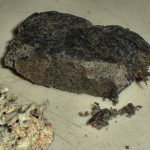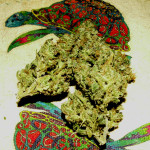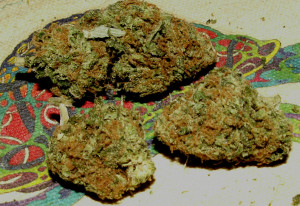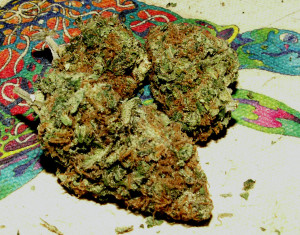Author Archive
Making Dry Ice Kief
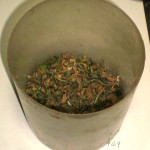 My first run with Dry Ice I used a DVD container.
My first run with Dry Ice I used a DVD container.
A couple dollars worth of dry ice was more than enough.
I used some 120 micron silkscreen I had and got an excellent batch off some Purple Kush trim.
 My next efforts went even better. I bought a Tupperware container that almost seemed to be made for the job.
My next efforts went even better. I bought a Tupperware container that almost seemed to be made for the job.
This time I went with 200 micron screen and the results were even better.
After you have the trim or bud and dry ice in and the top sealed let it sit for 5 or 10 minutes to chill out.
Flip it and shake it for about 1 minute or less. This first run will be the very best, collect it and set it aside for personnel stash.
 Turn it again and shake for a couple more minutes, depending on how much you are working with. It should all be virtually pulverized at this point.
Turn it again and shake for a couple more minutes, depending on how much you are working with. It should all be virtually pulverized at this point.
If you shake too long you will just reduce all the plant material to dust and end up with crap. You just want to knock the trichomes off through the screen.
After you have your Kief put it in a hash press and heat it to around 120 degrees for a couple minutes and your done.
No water, no ice cubes, minimal mess and the finest hash you can find if you do it right.
The Ultimate Guide to Cannabis Concentrates
They forgot Rosin, but otherwise a good article…
“Once you get locked into a serious drug collection, the tendency is to push it as far as you can“ – we couldn‘t agree more, Hunter.
Two types of concentrates: mechanical and solvent based
Mechanical Concentrates
Hashish – Kif – Charas, Nepalese Temple Balls and finger hash
Solvent based concentrates
Bubble Hash – Dry Ice Hash – BHO – Butane Hash Oil – Shatter – Budder – BHO Hash Oil / Wax – Solvent reduced Hash Oils – CO2 Extraction – Cannabutter – Vegetable Oil Extracts – Cannabis Tinctures
Read the article here:
http://www.zamnesia.com/blog-the-ultimate-guide-to-cannabis-concentrates-n805
Trademark registration
 Any word, design, logo, or combination of these used by a manufacturer or merchant to identify goods made or sold, or services provided in Alaska, may be registered by filing an application for state trademark registration. The filing fee is $50.00 per class of goods or services being registered.
Any word, design, logo, or combination of these used by a manufacturer or merchant to identify goods made or sold, or services provided in Alaska, may be registered by filing an application for state trademark registration. The filing fee is $50.00 per class of goods or services being registered.
You are strongly advised to conduct a thorough search of your mark before filing. If you require assistance, you are advised to seek the services of an attorney or other qualified professional specializing in the area of trademark law.
https://www.commerce.alaska.gov/web/cbpl/Corporations/TrademarkRegistration.aspx
https://www.commerce.alaska.gov/web/Portals/5/pub/pub_corp/08-547.pdf
 A trademark identifies the brand owner of a particular product or service. Trademarks can be licensed to others; for example, Bullyland obtained a license to produce Smurf figurines; the Lego Group purchased a license from Lucasfilm in order to be allowed to launch Lego Star Wars; TT Toys Toys is a manufacturer of licensed ride-on replica cars for children. The unauthorized usage of trademarks by producing and trading counterfeit consumer goods is known as brand piracy.
A trademark identifies the brand owner of a particular product or service. Trademarks can be licensed to others; for example, Bullyland obtained a license to produce Smurf figurines; the Lego Group purchased a license from Lucasfilm in order to be allowed to launch Lego Star Wars; TT Toys Toys is a manufacturer of licensed ride-on replica cars for children. The unauthorized usage of trademarks by producing and trading counterfeit consumer goods is known as brand piracy.
The owner of a trademark may pursue legal action against trademark infringement. Most countries require formal registration of a trademark as a precondition for pursuing this type of action. The United States, Canada and other countries also recognize common law trademark rights, which means action can be taken to protect an unregistered trademark if it is in use. Still common law trademarks offer the holder in general less legal protection than registered trademarks.
A trademark may be designated by the following symbols:
- ™ (the “trademark symbol”, which is the letters “TM”, for an unregistered trademark, a mark used to promote or brand goods)
- ℠ (which is the letters “SM” in superscript, for an unregistered service mark, a mark used to promote or brand services)
- ® (the letter “R” surrounded by a circle, for a registered trademark)
A trademark is typically a name, word, phrase, logo, symbol, design, image, or a combination of these elements. There is also a range of non-conventional trademarks comprising marks which do not fall into these standard categories, such as those based on color, smell, or sound (like jingles). A trademark cannot be offensive.
The term trademark is also used informally to refer to any distinguishing attribute by which an individual is readily identified, such as the well-known characteristics of celebrities. When a trademark is used in relation to services rather than products, it may sometimes be called a service mark, particularly in the United States. https://en.wikipedia.org/wiki/Trademark
Seriously Happy
Strain review: Seriously Happy
3rd prize in the category: ‘Sativa / Grower’ at the IC-420 Cup 2015 in Amsterdam
Type: Sativa hybrid, F1-hybrid, Sativa/Indica Hybrid
Origin: Serious Seeds, Warlock x AK47, grown locally from seed
Medium: Hydroponic
Lights: LED
Grower: NLCC
8.0 / Appearance: Frost! Any more frost and it would be hard to see the buds under there! Not snowy, but the most frosty thing in my stash box at present. well, no, I just checked the 2nd sample of another strain and it seems to be at least equally frosted (but with an enticing reddish mottling!)
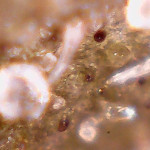 7.0 / Smell: Sweet and fruity, not overpowering, just inviting.
7.0 / Smell: Sweet and fruity, not overpowering, just inviting.
9.0 / Burn: It does.
8.5 / Taste: Ahhhhh…immediately struck by the richness, a smoke I want to hold on my tongue to savor the flavor. Very peppery as I might expect fr4om a good skunk.
7.0 / Exhale: smooth and easy but there is a cough lurking in the background, by the time I exhaled the high was already crawling up my face and peppercorns were dancing in my mouth.
 8.7 / High: Immediate satisfaction, usually when something hits me this quick I expect it to taper off quickly…waiting…
8.7 / High: Immediate satisfaction, usually when something hits me this quick I expect it to taper off quickly…waiting…
9.0 / Manicure: Yea, tight, solid 9, I think the only way to hit 10 here would be for it to be manicured by naked virgins right in front of me.
(8.0)Overall: Yea, like I’m gonna try and do the statistical averaging after burning a bowl of this…I’m happy not to and just say the high seems to be building and by the time I finish editing the pictures and posting this I expect this initial happy might transform into a serious happy which is all I’m really hoping for in a good recreational smoke, but the pain in both brain and body seem to pleasantly retreating. I think this could climb up onto any top shelf and feel right at home.
 (8.5) After action report: 30 minutes in and the mind high is pleasant, not feeling couch locked, body stone is very nice though. I almost feel like I could remember how to do algebraic calculations, not that I ever would. Only had to correct 3 words on proof reading, I could see this being a daily delight, certainly something to add to the rotation to keep from getting bored.
(8.5) After action report: 30 minutes in and the mind high is pleasant, not feeling couch locked, body stone is very nice though. I almost feel like I could remember how to do algebraic calculations, not that I ever would. Only had to correct 3 words on proof reading, I could see this being a daily delight, certainly something to add to the rotation to keep from getting bored.
Northern Lights Special
STRAIN: Northern Lights Special TYPE: mostly an indica ORIGIN: KC Brains MEDIUM: Hydro NUTES: CLASSIFIED GROWER: NLCC - Northern Lights Cannabis Company APPEARANCE: Sparkly and tight SMELL: A little skunk on the break BURN: Quite nice white ash finish TASTE: Nothing unexpected from NL, sweet EXHALE: smooth and hard to capture because I keep coughing HIGH: Immediate interest, no creeper bullshit here, kind of like a Pan Galactic Gargle Blaster.
MANICURE: Outstanding, as pro as they go. OVERALL: Northern Lights Special is indeed a special treat, the buds are hard, tight and beautiful. Great high, It took me several days to get this review done because I kept trying this stu8ff and then I'd wander off and do something else. Finally I sat down, rolled a joint and 12 hours and 10 minutes later here we are, a finished review, now if I could just remember how to post it.8/10
Off site reviews:
http://www.druglibrary.org/strainguide/KC_Brains/Northern_Light_Special_The_Original/734/index.html
Theresa Collins sounds off in style…
Esteemed Members of the Marijuana Control Board,
 Thank you for taking the time to review my comments on the last set of articles 1-9. I appreciate your time and diligence in crafting fair regulations. This is a monumental task and history making to say the least. Each of you have volunteered hundreds of hours to this cause and for that I think that I can speak for a majority of the industry in saying, “Thank you.”
Thank you for taking the time to review my comments on the last set of articles 1-9. I appreciate your time and diligence in crafting fair regulations. This is a monumental task and history making to say the least. Each of you have volunteered hundreds of hours to this cause and for that I think that I can speak for a majority of the industry in saying, “Thank you.”
This is my first time being involved in a regulatory process and it has been truly educational and an experience that I will never forget. In some instances I feel that I have gotten to know the boards thoughts and views and as I stated in my verbal public comment, you all chose to be a part of this process because of your care for the sector you represent and I respect this immensely.
I want to start my final public comment by giving you some history and insight as to why I personally think that this industry is so important for Alaska and Alaskans and why I chose to be a part of this industry.
Early last year I was approached by longtime family friends and asked what my thoughts were on the legalization of marijuana in Alaska. I did not consume marijuana but I certainly was not against responsible adult use, especially when it pertained to people that need it medically. At the same time two of my Mother’s cousins had used Rick Simpson Oil to combat two different types of cancer. My family had already witnessed two medical miracles when both of her cousins went into remission and hence made my very susceptible to the idea of safe access both medically and for recreational purposes. They asked me if I would entertain the idea of going into the industry as they thought that the value I had brought to the company I worked for at that time would be a valuable asset to a partnership with them in the future. However, I was unsure if I wanted to leave the company that I worked for as I had been there for almost 10 years and did not have any plans to leave.
Fast forward a few months and I found myself in a medical situation. I was prescribed narcotics for my pain. This was not an option for me as my sensitivity to narcotics in the past had made me very sick. A friend suggested I should try marijuana for the pain. That day I smoked for the first time in years. Within three minutes my pain level went from a 8 to a 3. It was in that moment I decided that I wanted to help people and I knew that I wanted to be involved in this industry.
I started researching and learned a lot from the states that had legalized marijuana before Alaska had. There were key items I took away from this research and implemented into my business plan. One of them being that Alaska could never generate the revenue that either Colorado or Washington had in their first year of legalization due to our population size and geographical location. I started to take averages and numbers and formulated my analysis to represent the industry as whole, not just for my business. The one thing that I took away from this is that without tourism industry the marijuana industry would be okay for Alaska, at best.
Here is an example breakdown of how I came to this conclusion with my research from Colorado. After reading the two different state’s regulations I felt that Colorado’s approach to the industry was better from a business standpoint then the way that Washington set up their regulations. In 2014 approximately 60% of sales in Colorado were from out of state. I took into consideration that this number in Alaska will be considerably lower because of our geographic regions. Colorado is bordered by several states where recreational marijuana is illegal and Alaska is not bordered by any other states.
In 2014 there were 736,732 residents in the state. A conservative average of the amount of adult cannabis users in Alaska is 20%, making the potential for 147,346 consumer in Alaska. On average an adult consumer consumes 3.5 grams per week. If you price that at $40.00/3.5 grams (current black market value) the amount that the industry would bring in is around 306 million dollars. In 2014 Colorado made over $700 million in sales, $63 million in taxes, an additional $13 million in licenses and fees were collected by the state. The industry in Alaska can be just as lucrative as Colorado if we include the number of tourists that visit Alaska each year. According to the Economic Impact of Alaska’s Visitor Industry (2013-14 Update) in 2014 there were 1.93 Million visitors to the state of Alaska. If 20% of those visitors stay an average of 1 week and buy and consume approximately $100 worth of marijuana products the additional revenue stream for the state would be an estimate of $386 million, putting us in the same income potential as Colorado.
I believe in this industry for Alaska. Alaska has a proven track record in creating sustainable industries through natural resources and marijuana is just that, a natural resource, a plant. Through proper regulation and industry development this industry can help bridge the fiscal gap in Alaska. In the future providing hemp as a resource and expanding our tourism industry will only help the cannabis industry flourish.
If we all work together I feel that these goals can be achieved. There are a lot of very smart individuals that I have met that have great ideas on how to make this industry good for the state. I encourage the board to work with industry leaders and adapt to the changes that will need to be made in the future. This is new to all of us and if we work together to accomplish the same goals future states will look to us for guidance. Alaska is the first state to legalize recreational marijuana without any medical infrastructure and other states are looking to us as we looked to Colorado and Washington to set an example.
3 AAC 306.010 (a) License restrictions.
(a) The board will not issue a marijuana establishment license if the licensed premises will be located within 500 feet of a school, a recreation or youth center, a building in which religious services are regularly conducted, or a correctional facility. The distance specified in this subsection must be measured by the shortest pedestrian route from the public entrance of the building in which the licensed premises would be located to the outer boundaries of the school, recreation or youth center, or the main public entrance of the building in which religious services are regularly conducted, or the correctional facility. This section does not prohibit the renewal of an existing marijuana establishment license or the transfer of an existing marijuana establishment license to another person if the licensed premises were in use before the school, recreation or youth center, the building in which religious services are regularly conducted, or the correctional facility began use of a site within 500 feet. If an existing marijuana establishment license for premises located within 500 feet of a school, a recreation or youth center, a building in which religious services are regularly conducted, or a correctional facility is revoked, or expires, the board will not issue another Register , 2016 COMMERCE, COMMUNITY, AND EC. DEV. 10/1/2015 4 marijuana establishment license for the same premises unless the school, the recreation or youth center, the building in which religious services are regularly conducted, or the correctional facility no longer occupies the site within 500 feet.
Comments: There should be an exception added for local option to adjust the distance as necessary in their community. During verbal comments there were a lot of local governance representatives that commented that the state restrictions would not work in their community.
3 AAC 306.010 (c) (3)
Operated a marijuana delivery service, a marijuana club, or a marijuana establishment illegally without a license issued under this chapter, or otherwise violated AS 17.38, during the two years before the date the person files the application, unless the board finds that person has diligently worked with the board to comply with all current laws and regulations relating to marijuana.
Comments: I believe for obvious reasons that this should be changed. The definition of legal is very unclear in this industry. As an example, we did our due diligence before opening our private club. To date there is still no statue that says we are illegal. Does this mean we would be included in this group? We could have operated in the gray area when we opened our doors and handed our ‘free’ marijuana but we chose not to as we wanted to chose the path that was responsible until regulations were set. In choosing to follow the law to run a completely legal club it has been very financially straining but we continue to stay open as there is a real need for these clubs. Being that we have over 1800 members solidifies the need. We provide a place for members to consume and share their own cannabis. There are no sales, donations, or money exchanged for cannabis in our club. Who will be the ones to define what is legal and what is not? Please remove Marijuana Club from this section or define marijuana club as a club that distributes marijuana for capital gain through donations.
3 AAC 306.015 (b) 1-4 License conditions.
(a) The board will issue each marijuana establishment license to a specific individual, to a partnership, including a limited partnership, to a limited liability company, to a corporation, or to a local government. A person other than a licensee may not have a direct or indirect financial interest in the business for which a marijuana establishment license is issued. (b) The board will not issue a marijuana establishment license to (1) an individual or a sole proprietorship unless the individual or proprietor is a resident of the state; (2) a partnership unless each partner is a resident of the state; (3) a limited liability company unless the limited liability company is qualified to do business in the state, and each member of the limited liability company is a resident of the state; or (4) a corporation unless the corporation is incorporated or qualified to do business in the state, and each shareholder who owns the corporation’s shares is a resident of the state.
Comments: Please change this restriction to allow for 25% outside investment. In this industry we will not be able to get business loans from banks, making this restriction unreasonably impracticable. In order for this industry to succeed we need to pull all resources available. I agree that we want these businesses to be majority owned by Alaskans but would like to see practical regulations allowing for our industry to succeed with the possibility of up to 25% outside investment.
3 ACC 306.310 (a)(4)Acts prohibited at retail marijuana store.
(a) A licensed retail marijuana store may not sell, give, distribute, deliver, or offer to sell, give, distribute, or deliver, marijuana or any marijuana product (4) over the internet; a licensed retail marijuana store may only sell marijuana or marijuana product to a consumer who is physically present on the licensed premises;
Comments: This is a clarification really. Can a person order online and pick and pay for product in person?
3 ACC 306.310(b)(3)(B)
(b) A licensed retail marijuana store may not (3) offer or deliver to a consumer, as a marketing promotion or for any other reason (B) a consumable product other than marijuana, including cigarettes, tobacco products, alcoholic or non alcoholic beverages, or food, free or for compensation.
Comments: A retail location should be able to sell other non-marijuana related products to offset the cost of doing business. It is going to be difficult enough with the current tax structure for licensed marijuana facilities to write off cost of goods. If they these facilities are allowed to sell non-marijuana related products it can be beneficial to operational costs for the licensees.
3 ACC 306.320 (2) Marijuana handler permit required.
A retail marijuana store shall ensure that (2) each licensee, employee, or agent has that person’s marijuana handler permit card in that person’s immediate possession when on the licensed premises of the retail marijuana store.
Comments: Employer should be allowed to keep handlers permits on location. Most cultivation facilities will require employees to change clothing before they enter restricted areas. I think it would be more beneficial to require the employee to have their handlers permit on site. As an example, bartenders may have their TAMS card in their purse but it necessarily does not have to be on their person. This should be the same for Marijuana Handlers permits.
3 ACC 306.360 (d)Restriction on advertising of marijuana and marijuana products.
(d) A retail marijuana store may not use giveaway coupons, or distribute branded merchandise as promotional materials, or conduct promotional activities such as games or competitions to encourage sale of marijuana or marijuana products.
Comments: Licensed companies should be allowed to give away branded merchandise and coupons to their facilities. There are already stringent regulations around marketing and advertising and this would further hinder the industries ability to have a successful business. The American Marketing Association (AMA) defines a brand as a “name, term, sign, symbol or design, or a combination of them intended to identify the goods and services of one seller or group of sellers and to differentiate them from those of other sellers.
Please review article link on the importance of marketing your brand. I could not spoy and paste it as it would violate copyright laws:
http://www.decisionanalyst.com/publ_art/brandequity.dai
In Alaska we face an estimated $3.7 billion dollar budget deficit. I am not saying that marijuana is the only answer, but it could certainly help. I know that we cannot quite compare it to The Great Depression, but in almost every article I read about the importance of marketing with the exception of the link above, The Great Depression was referenced. The companies that survived were the ones that continued to market and brand themselves. The companies going into this industry are no different and need to be allowed to market and brand in order to be successful. Not only that but as business owners we should be allowed to market and brand our companies as we see fit as long as we are following the guidelines you proposed as far as types of advertising that protect people under the legal age of consumption of 21.
What Companies Survived the Great Depression & How They Did
written 03/03 Gail Oliver theurbanshaman@aol.com
To state a generality, those companies who not only survived but did well and grew during the Great Depression are those who continued to act as though there were nothing wrong and that the public had money to spend. In other words, they advertised. These are industries who didn’t wait for public demand for their products to rise, they created that demand even during the most difficult of times. Because so many
companies cut spending during that era, advertising budgets were largely eliminated in many industries. Not only did spending decline, these companies actually dropped out of public sight because of short sighted decisions made about spending money to keep a high profile.
These advertising cutbacks caused many customers to feel abandoned and associated the effected brands with a lack of staying power. This not only drove customers to more aggressive competitors but caused a certain among of financial mistrust when it came to making additional investments in the no longer visible companies.
Both anecdotal and empirical evidence support the case that advertising was the main factor in the growth or downfall of companies during those years. To put it bluntly, the companies which demonstrated the most growth and which rang up the most sales were
those which advertised heavily. The Great Depression offers classic examples of the power of brand advertising even during times of economic crisis.
Proctor and Gamble – This is a company which has a philosophy of not reducing advertising budgets during times of recession and they certainly did not make any such reduction during the Depression. P&G has made progress in every one of the major recessions and that is no accident. When their competitors were swinging the budget axe, P&G actually increased their spending. While the Depression caused problems for many, P&G came out of it unscathed. Radio took P&G’s message into more homes than ever.
Chevrolet – During the 1920s, Fords were outselling Chevrolets by 10 to 1. In spite of the Depression, Chevrolet continued to expand its advertising budget and by 1931, the “Chevy 6” took the lead in its field and remained there for the next five years.
Camel Cigarettes – in 1920 Camel was the top selling tobacco product. American Tobacco Company then struck back with the Lucky Strike brand and by 1929 Lucky had overtaken Camel as the number one brand. Two years later in the heart of the Depression, Chesterfield also overtook Camel. Camel countered with a massive increase in advertising spending and by doing so demonstrated the power of advertising during depressed times. By 1935, it was back on top.
Now, these examples count as anecdotal. But in addition to these examples, studies have demonstrated that during times of recession, companies that maintain advertising during these periods experience higher sales and profits during the downturns and afterward than
companies who cut their advertising budgets.
It was also the very nature of this advertising that spurred the growth of two other industries during the Depression. The first of which was radio broadcasting.
Let’s return to Proctor and Gamble for a while. P&G first turned to radio in 1923 advertising Crisco on a New York station. Other products such as Ivory and Lava soap were advertised on ‘product oriented’ shows which were similar to today’s infomercials. But in the heart of the depression P&G took a step which changed not only that company but the broadcast medium forever while creating great demand for its products. The president of P&G at the time was Richard Deupree. In spite of the fact that shareholders were demanding that he cut back on advertising, he knew that people were still buying essential household products. So he created radio programming that did not focus on a product. Because of that, we now have a cultural attribute known as the “soap opera.”
In 1933, P&G went on the air with its first “soap” – “Ma Perkins,“ sponsored by Oxydol. P&G was so satisfied with the increase of sales, they went on to introduce “Vic and Sadie” for Crisco, “O’Niells” for Ivory Soap and “Forever Young” for Camay. By the time 1939 rolled around, P&G was sponsoring 21 radio programs and they doubled their radio advertising budget every two years during the Depression.
Radio was one of the fastest growth industries of the depression. P&G virtually built daytime radio with its advertising budgets and programming. Two industries were thriving from the advertising budget of one.
The print media was also a growth industry during the Depression. To give some reason for this, we now return to Chevrolet. the first ads for Chevrolet appeared in print in 1914. In 1927, they began to increase their print advertising budget. As the country moved into the Depression a couple of years later, Chevy did not let its commitment to print advertising falter and its car ads not only kept some publications afloat, it helped many to grow. In as much as the term “print media” covers many outlets, they pioneered the outdoor advertising medium, billboards. Chevrolet also went into radio and sponsored such Depression Era classics as Fred Allen and Jack Benny. Chevy’s print ads appealed to the “emotional” side of a buying decision which was a great move in light of the economic uncertainty of the time.
So once again, those companies which took advantage of the Depression and came through in good form were those who kept their name in front of the public in spite of a lack of purchasing power. Your question asks about a hierarchy of demand from essential consumables to deferrable purchases to capital goods. In reality there was no such hierarchy. I have tried to balance the examples given to show some spectrum across the board. Proctor and Gamble represents essential consumables, Chevrolet represents deferrable purchases and Camel represents non-essential products. So as you can see, the so called hierarchy of necessity and want was sidestepped by those who had the marketing gumption to ignore such distinctions. However, capital goods information needs to reflect the entire economic structure of the Depression and not just those companies which were successful. Overall, new production of capital goods less
capital goods consumed during the years 1929 – 1939 was near zero. The increase in the money supply during the 1920s also increased the prices of capital goods relative to the prices of consumer goods. This disparity set in motion a boom in real estate and stock market prices and interest rates were driven down by the “increase in Fed money. It must also be noted that the preceding statement on capital goods is only one of many competing economic theories about the Depression. There are some who say this compounding of assertions is wrong from beginning to end. But in composing an answer such as this, there needs to be one which best meets the nature of the question and in
conjunction with the material about public visibility covered above, this is the one your researcher ties into the equation. When money has entered the economy from whatever sources during business fluctuations in the past, has there been a disparity between
the increases in prices of capital and consumer goods? That alone is a subject which would take volumes to answer. In fact, it would take volumes just to cover the debate without any resolution coming about. As far as the end of your question as to what distinguished the companies that did well during the Depression? They were the companies that kept their name in front of the public and created brand name recognition even during the worst of times. – Gail Oliver theurbanshaman@aol.com
Search – Google
Terms – great depression, company growth great depression, great depression success stories, brand name awareness great depression, advertising history, new industry great depression, benefits of advertising
Websites used to compose the above:
“America’s Great Depression – Causes and Cures” http://www.amatecon.com/gd/gdcandc.html
“H102 Lecture 19: The Great Depression and the New Deal” –http://us.history.wisc.edu/hist102/lectures/lecture19.html –
University of Wisconsin, Stanley K. Schultz, Professor of History
“Sliding into the Great Depression” –http://econ161.berkeley.edu/TCEH/Slouch_Crash14.html – University of California at Berkeley
“Great Myths of the Great Depression” – http://www.uaca.ac.cr/acta/1998nov/lreed.htm – Universidad Aut noma de Centro Am rica
“Economic Surpluses” – http://www.sjsu.edu/faculty/w atkins/surplus.htm – San Jose State University
“Accounting for the Great Depression” – http:/www.stern.nyu.edu?~fperri/papers/account.pdf – a PDF file, Acrobat Reader needed.
“Four Myths About America’s Great Depression” –
http://www.libertyhaven.com/…/economichistory/fourmyths.html
– From Liberty Haven
“EAP Vocabulary – Exercise” – http://www.uefap.co.uk/vocab/exercise/buscycl.htm – some interesting
information about capital goods and business cycles here but mostly in
a modified glossary format
“Creating Mass Culture” –http://xroads.virginia.edu/~CLASS/am485_98/graham/mass.html – University of Virginia
“The Visitor in Your Living Room: Radio Advertising in the 1930s” –http://xroads.virginia.edu/~CL…/am485_98/graham/visitor.html –
University of Virginia
3 AAC 306.405(c)(2)
(c) A licensed standard marijuana cultivation facility may not (2) allow any person, including a licensee, employee, or agent, to consume marijuana or a marijuana product on the licensed premises or within 20 feet of the exterior of any building or outdoor cultivation facility on the licensed premises;
Comments: A private employee break room in which consumption of marijuana is permissible should be allowed at employers discretion, especially when it comes to employees that are medical card holders. This industry is finally going to allow these medical patients to have jobs that they can mediate and not have to worry about their job being in jeopardy with the possibility of a Urine Analysis. 17.38.120 (d) states: (d) Nothing in this chapter shall prohibit a person, employer, school, hospital, recreation or youth center, correction facility, corporation or any other entity who occupies, owns or controls private property from prohibiting or otherwise regulating the possession, consumption, use, display, transfer, distribution, sale, transportation, or growing of marijuana on or in that property. This section expressly goes against the initiative and needs to be removed.
3 AAC 306.410 (a) 1 Limited marijuana cultivation facility: privileges and prohibited acts.
(a) A licensed limited cultivation facility is authorized to (1) propagate, cultivate, harvest, and prepare marijuana for sale in a marijuana cultivation facility with fewer than 500 square feet under cultivation;
Comments: Limiting a small grow operation for a limited license to 500′ would not be a viable option for most small growers if they have to rent out a commercial property. The only was I see this working is if home cultivation is allowed similar to a home brew license. If home grows are not allowed I believe the limited cultivation license should be at minimum 1000 sq ft and maximum of 1999 sq ft, making anything above that a standard cultivation license. If we want to see the black market diminish we must make the limited licenses a viable solution for people to legitimize their craft. This section also makes a limited grow facility unreasonable impracticable as per section 17.38.090, cited below.
Sec. 17.38.090. Rulemaking. (a) Not later than nine months after the effective date of this act, the board shall adopt regulations necessary for implementation of this chapter. Such regulations shall not prohibit the operation of marijuana establishments, either expressly or through regulations that make their operation unreasonably impracticable.
Comments: Upon analyzing the business opportunities that would be available for Alaskans here are some rough estimates to present to the board as to why this limit would be unreasonably impracticable.
500′ can produce up to 100 plants if the plants take up less then 5′ each. On average a plant produces 4 ounces. Typically average street value for an ounce of marijuana is about $240.00 per ounce (the industry anticipates this number going down once this is a regulated market, easier access to a product means price reduction in said product, a conservative estimate would be $200 per ounce). In order to be producing continuously throughout the year you will be able to cultivate around 25 plants per crop, giving you 100 ounces every 3 months. At current black market value you would produce enough marijuana to make $8000 per month before cost. When you add the $50 excise tax to each once this number goes down to $6,333 per month. Once you add additional operational cost, rent, utilities, soil, nutrients, wages, insurance, broker fees, etc this number decrease dramatically. A conservative amount for the monthly cost of doing business would be $4000/month which decrease the monthly income to around $2300/month, and remember, this is a conservative number. This means a person operating a limited license grow could have the potential to make an additional $27,600/year. Again, these numbers are very conservative. This would make this type of license unreasonably impracticable.
3 AAC 306.410 (a) 3_Limited marijuana cultivation facility: privileges and prohibited acts.
(a) A licensed limited cultivation facility is authorized to (3) sell marijuana only to a licensed marijuana cultivation broker facility with which the limited cultivation facility has a written agreement that
Comments: Please remove the requirement for a limited cultivation licensee to sell only to a broker. As you can see from the analysis above this would again go against 17.38.020, making this business model unreasonably impracticable.
3 AAC 306.410 (b) 2
(b) A licensed limited marijuana cultivation facility may not (2) hold any other type of marijuana establishment license;
Comments: A limited cultivation licensee should be allowed to hold other licenses. Nowhere in the initiative does it say that a person cannot hold multiple licenses. This again, goes against 17.38.020, making this business model unreasonably impracticable. A person holding a limited cultivation license should be allowed to have a dispensary and process their own product, just like a standard cultivation facility. It should be up to the business owner to be able to maximize their full business potential, not up the board.
3 AAC 306.410 (b) 4
(b) A licensed limited marijuana cultivation facility may not (4) sell to any marijuana establishment except through a marijuana cultivation broker facility;
Comments: A limited cultivation licensee should not be required to use a broker. They should be able to chose what is practical for their own business. Either that or they should allowed to hold a brokers license for themselves as well. Nowhere in the initiative does it mention anything bout the requirement to use a broker. Please remove this requirement.
3 AAC 306.420 (a)(2) Application for marijuana cultivation facility license.
(a) An applicant for a new standard marijuana cultivation facility license or a new limited marijuana cultivation facility shall file an application on a form the board prescribes, including (2) the proposed marijuana cultivation facility’s operating plan, including, in addition to the information required under 3 AAC 306.020(c):
Comments: A basic operating plan should be submitted to the board but not a complete operating plan. This would require a business owner to share their trade secrets with the board and should not be required. I believe a basic operating plan should be submitted or an outside source needs to review the plans for the board and sign a confidentiality agreement making them liable for any theft of trade secrets. We do not need there to be any accusations made and waste any tax payers dollars on any litigation that could arise.
3 AAC 306.480(a) Marijuana tax to be paid.
(a) A standard marijuana cultivation facility shall submit monthly reports to the Department of Revenue and pay the excise tax required under AS 43.61.010 and AS 43.61.020 on all marijuana sold, or provided as a sample to any marijuana establishment.
Comments: Please add a section to set excise tax on trim. I have seen many comments asking that it be 10% or $5 per ounce of trim. I thin this is reasonable as we do not want to see cultivators destroy usable product instead of paying $50 an ounce for product that does not hold the value that flower does.
3 AAC 306.510 (a) 3 Acts prohibited at marijuana product manufacturing facility.
(a) A licensed marijuana product manufacturing facility, including a licensed marijuana concentrate manufacturing facility, may not (3) allow any person, including a licensee, employee, or agent, to consume marijuana, marijuana concentrate, or a marijuana product on its licensed premises;
Comments: Consumption of marijuana should be allowed at employers discretion, especially when it comes to employees that are medical card holders. This industry is finally going to allow these medical patients to have jobs that they can mediate and not have to worry about their job being in jeopardy with the possibility of a Urine Analysis. 17.38.120 (d) states: (d) Nothing in this chapter shall prohibit a person, employer, school, hospital, recreation or youth center, correction facility, corporation or any other entity who occupies, owns or controls private property from prohibiting or otherwise regulating the possession, consumption, use, display, transfer, distribution, sale, transportation, or growing of marijuana on or in that property. This section expressly goes against the initiative and needs to be removed.
3 AAC 306.510 (a) (4) (B) Acts prohibited at marijuana product manufacturing facility.
(a) A licensed marijuana product manufacturing facility, including a licensed marijuana concentrate manufacturing facility, may not (4) manufacture or sell any product that (B) is a marijuana product containing any food that requires temperature controlled storage to keep it safe for human consumption;
Comments: I recently traveled to Oregon to review the industry in their state. Every dispensary that I visited had refrigerators for products that need temperature control. This should be removed as per requirement the companies producing edibles will need to also carry a food handlers permit and there are already stringent requirements through the state handlers permits that these operators will need to follow. In my research I was unable to find any state regulation that prohibits the sale of temperature controlled items. Their are requirements for the handling of said products and companies will be required to follow these guidelines. This is over regulation and should be removed or edited to say; unless said operator is in compliance with state and local requirements for food handling.
3 AAC 306.510 (a) (5)Acts prohibited at marijuana product manufacturing facility.
(a) A licensed marijuana product manufacturing facility, including a licensed marijuana concentrate manufacturing facility, may not (5) operate in a location that is a retail or wholesale food establishment.
Comments: Setting up a commercial kitchen is very expensive. Edibles companies, just like catering companies should be allowed to rent out commercial kitchen space in an existing kitchens if they chose. The fear of cross contamination is unfounded as mentioned above, these companies will have to have food handlers permit. I myself have severe allergies to countless foods, yet I still eat in kitchens where said food is prepared because of the stringent regulations food establishments have. Please remove this section.
3 AAC 306.525 (a) (1)Approval of concentrates and marijuana products.
(a) A marijuana product manufacturing facility, including a marijuana concentrate manufacturing facility, must obtain the board’s approval for each product it will manufacture for sale or transfer to another licensed marijuana establishment. The board will not approve (1) any marijuana concentrate or product intended for sale directly to a consumer if the concentrate or product will have THC potency equal to or greater than 76 percent; or
Comments: The potency limit being set at 76% is not feasible for this industry. I have attached testing reports that I was allowed to photograph along with a video I hope you may review. After reviewing hundreds of lab reports we were only able to find 2 products that were under the 76% limit. This limit is no practicable as a person making their own concentrates at home can exceed this limit very easily as demonstrated during the verbal public comment period. Medical patients need to be able to have higher concentrate levels available for purchase without having to make their own medicine in their homes. If commercial facilities are required to have this limit they will nee to adulterate the product, possibly causing safety issues for consumers. It is imperative that you change this limit or remove it all together.
3 AAC 306.560 (a) (1) Potency limits per serving and transaction for edible marijuana products.
(a) A marijuana product manufacturing facility may not prepare any product with potency levels exceeding the following, as tested in compliance with 3 AAC 306.645: (1) for a single serving of marijuana product, five milligrams active tetrahydrocannabinol (THC) or Delta 9;
Comments: It concerns me that we are being more prohibitive then states that are currently allowing recreational sales. In Oregon you cannot even find edible products with anything less then 10mg per serving. Of course the edibles in Oregon are for medical patients only, but since we do not have any medical infrastructure currently defined in the regulations it will prohibit medical patients from getting the dosages they need. This would only cause the black market to flourish as medical patients and rec users may not purchase edibles with such a limit placed on the market. Please change the individual dosage to 10mg per serving and 100mg per package and consider doubling that for medical card holders.
3 AAC 306.900 (a)-(c) (1) -2) Marijuana clubs prohibited.
(a) A person may not maintain a place where marijuana or marijuana products are received or kept, or to which marijuana or marijuana products are brought for consumption by the public or by members of a club, association, or corporation unless the person is authorized to do so under this title. (b) A person may not maintain, operate, or lease premises for the purpose of providing a place for consuming marijuana or marijuana products for consideration by members of the public or other persons, unless the person is authorized to do so under this title. (c) In this section, “consideration” includes a membership fee, a cover charge, the sale of food, ice, mixers, or other drinks, or the furnishing of marijuana accessories for use in the consumption of marijuana or any marijuana product.
Comments: I would like to start this section by including a link to the legal definition of clubs. I could not copy and paste this section but I encourage you to review it.
http://legal-dictionary.thefreedictionary.com/Private+club
To summarize, a club is a legal entity as long as they are following state statutes and have its members read the rules or bi laws and bind their membership by agreeing to said rules. Pot Luck Events is no different then the cigar clubs or sex clubs that operate in Alaska. As long as we are following state statute (and we are), we will remain legal.
Furthermore, several sections in this section are also prohibited per AS 17.38.
Sec. 17.38.090. Rulemaking. (a) Not later than nine months after the effective date of this act, the board shall adopt regulations necessary for implementation of this chapter. Such regulations shall not prohibit the operation of marijuana establishments, either expressly or through regulations that make their operation unreasonably impracticable.
Sec. 17.38.120 (d) states: (d) Nothing in this chapter shall prohibit a person, employer, school, hospital, recreation or youth center, correction facility, corporation or any other entity who occupies, owns or controls private property from prohibiting or otherwise regulating the possession, consumption, use, display, transfer, distribution, sale, transportation, or growing of marijuana on or in that property. Pot Luck Events has always been deemed a private events club that is 420 friendly.
Please remove this section. If the board does not have the authority to create this license then it does not have the authority to prohibit it either.
In closing, I would like to thank you again for taking the time to review my comments and take into consideration all of the public comments you have heard throughout this process.
Theresa Collins
CEO and Founder of Pot Luck Events
In Mexico, cannabis is now legal–but only for four as yet unnamed Mexican citizens.
When Mexico’s Supreme Court ruled last week that consuming marijuana was constitutionally legal, it left the world shocked and somewhat confused.
In a 4-1 vote announced Wednesday in Mexico City, the five-justice panel declared the personal recreational use of marijuana legal under the right of “free development of personality.” In the same paragraph, however, the Court cautioned that its groundbreaking decision applied only to the four anonymous plaintiffs who filed the case. It did not, in the Court’s words, “imply a general legalization.” In Mexico, cannabis is now legal–but only for four as yet unnamed Mexican citizens.
Chapter 306. Regulation of Marijuana Industry
Register , 2016 COMMERCE, COMMUNITY, AND EC. DEV.




































































































































Regulation of Marijuana Industry
This page contains public documents relating to the regulations process for implementation of AS 17.38 governing the Production, Sale and Use of Marijuana, also known as Ballot Measure 2.
- PDF Format (opens in new window)
- DocX Format (opens in new window)
- HTML ZIP
- HTML (opens in new window)



